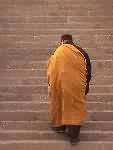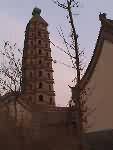- Getting around Lijiang. Dont stay in the Old Towns more than 2 days, there is nothing to do. KRISS Oct 9, 2013 05:46
- 2013 Beijing Temple Fair BENNYLAU Feb 26, 2013 03:29
- Malaysian traveling from KUL - LAX vis Shanghai PVG ZATI_DY Jan 3, 2013 20:15
City of the Phoenix
- Views: 5096
- |Vote: 2 0
- |Add to Favorites
- |Recommend to Friends
Ningxia's Golden Age
Countries as large as China couldn’t possibly be said to have simple histories. You can’t look into China’s past and see one continuously evolving civilisation – even the succession of dynasties memorised by every Chinese Primary School student lists only the highlights. Go back a thousand years or two, and there are little kingdoms everywhere, existing at the same time, each struggling for dominance. As they fell, their unique qualities were lost or blended into the culture of their conquerors, and history moved ahead, soldier by soldier, bringing China into its present state of wonderful, unified chaos.
The great, 189-year Western Xia dynasty is one of China’s lesser-told tales of a people that enjoyed a brief flower of culture a millennium ago in the Chinese Inner-Northwest. They commanded a seldom-ventured branch of the Silk Road that headed a long way North of Xi’an before turning west, and their capital was Xingqing, now called Yinchuan – ‘Silver River’ – in the North of what is now Ningxia province. Twelve kings ruled in turn over a civilised paradise of culture and prosperity in an oasis in the desert, under constant threat and suffering frequent attacks by surrounding kingdoms. They had their own literature and series of highly embellished Chinese characters, and they invented the first wood-type printing system in the world. When they were conquered by the great Genghis Khan, China lost an important branch from their tree of enlightenment.
I travelled to Ningxia by day train from Lanzhou in Southern Gansu. It’s a sensible route; in fact, Ningxia was actually considered part of Gansu until 1958, when it was established as a semi-autonomous province for the Hui Muslim Chinese. The train crosses the Yellow River by a magnificent bridge just outside the city, and works its way up to the border through dry, desert country. Through and into Ningxia, the barren lands are home to desperate men, clinging to dusty colonies of caves and disintegrating brick. The uniform ochre of the countryside is occasionally broken by schoolhouses and train stations of cracked wood coated in fading red paint, blown bare in the sand.
I walked right through the train from carriage to carriage, end to end. It was an older train without air conditioning, and all the windows were wide open, creating a steady breeze right along its length. The interior was overwhelmingly green, a shade more olive than the shell of the train, which was all dark green like a string of smoky peapods.
It wasn’t quite so crowded as I’d thought – there were a few sleeper cars that were all a little pokey, and the rest were hard seat carriages, which in off-peak seasons can be quite roomy with wide tables for reading, eating, and the essential – card playing.
Far out the left window of the train, the distant Great Wall reaches along the mountain ridges towards the West. If you look closely, you can see it, but I was more in the mood for looking at the people – wondering about what they might be thinking and doing. There were folks chatting, but more were quiet, and many were asleep in their seats or on their bunks, despite it being midday, as if the train ride were an inconvenience to be escaped by switching off power. Not being one of the more expensive trains, the passengers made no pretenses of fancy. Dark, sun-bronzed arms protruded from light-coloured cotton shirts, and many wore fawn cotton trousers with skin-tone socks. Dress varied little between the carriages, even between the different ticket classes – the most significant difference between the different economic groups was something intangible in their eyes. The privileged held steady gazes and expressions of confidence and curiosity; the disadvantaged sat emotionlessly with stares that looked at nothing. Their eye colours, varying from deep rich black to hazel with stains of lime, set against their tan with disturbing confessions of emptiness.
A child sat next to me in the evening as the desert took on its blue veil. She talked to me about her home in Yinchuan and her hopes for her future. Yinchuan is a beautiful place, she told me, in a province that is lush and green in the desert. Other Ningxia people seemed to share the same delighted pride in their province. Although small, it is certainly very special – and the main reason it’s remained a paradise whilst the desert around it has spread into the farmlands contaminated with eroding soil is the complicated series of irrigation canals originally built by China’s first emperor, Qin Shi Huang, and still in use today. The water from the Yellow River is directed throughout the province, creating rich and fertile lands. Travellers have described Ningxia as possessing ‘the fields of the South, in lands to the North of the Great Wall’. Yinchuan is a particular beauty, shaded from sandstorms by Mount Helan, and famous for its production of the Chinese Wolfberry, which is a prized medicine. The girl next to me had two in her pocket, which she squeezed into my palm as she got off the train.
Exploring Yinchuan
It was evening, and in the blue cool I wandered out from the station along wide, bare roads, looking for a place to spend the night. A short distance away was the Tao Yuan, on Tiedong Road, which had comfortable facilities and enough hot water to wash the desert away from me for the night.
I wouldn’t have enough time in Ningxia to check out the more remote attractions – perhaps the most famous of which is the Xumi Shan Grottoes in the South. Buddhist settlements living off the Silk Trade Route carved sculptures of the Buddha into the red sandstone there as long as 1500 years ago. Closer to Yinchuan, however, and more unusual, are the Tombs of the Kings of the Western Xia. These great mounds of earth resembling crumbling beehives were not recognised for what they were until the 1970’s. At the foot of Helan Shan, they entomb 9 of the 12 Western Xia kings and an entourage of almost 150 others, all scattered throughout the fields like the husks of sunflower seeds. Some visitors refer to them as the pyramids of China. Although they look like great clods of soil, a closer examination reveals that they are designed like cities, with fallen walls and collapsed structures of clay towers.
I had the day to explore the city itself, which was interesting enough. Yinchuan had a remote feel and a fresh atmosphere that is immensely attractive. It became known as the Phoenix City after a legend telling of a young phoenix who could not bring herself to leave the city with her older sisters, having been mesmerised by its beauty. I was looking forward to seeing as much of it as possible, and so I got up early and took the bus from outside my hotel into the old districts of the city.
The bus stopped at Nan Men, and when I came to it, I was rather surprised to see a very familiar sight – there, in the far Inner North of China’s remote Ningxia province, was what appeared to be a close adaptation of Beijing’s Tiananmen gate. Nan Men, whilst smaller than Tiananmen, has been restylised in red with a painting of Chairman Mao at its front – the only major difference being the white framing and white paneling in the tower above the gate. Nan Men stand as the focus of a wide public square, surrounded by a great number of small eateries selling lamb dumplings – lamb being the most widely eaten meat throughout Islamic China, Muslims being forbidden to eat or even touch pork.
Just south of the gate is Yinchuan’s major Islamic temple, the Nanguan Mosque. The mosque has stood through 90 years of uncertain history for the Hui minority people, and has survived as a splendid symbol of the faith in the region. The mosque is topped by five dark green domes, a central dome representing Mohammed and four smaller domes for the four schools of Islamic thought.
I continued to walk, heading west and turning north, making sure to pass the old Qing Dynasty Drum Tower and Yuhuang Pavilion on my way to my next destination, the Zizhi Qu Museum and Chengtian Temple at the foot of Yinchuan’s Western Tower. The tower and temple date back to 1050, right at the beginning of the Western Xia period, and the museum contains some extraordinary finds from this until recently lost dynasty. What fascinated me more than anything else were the examples of Xia dynasty writing. The Xia characters make traditional Chinese writing look simple. They are similar in shape and composition, but the most basic characters have at least ten strokes, and the result is that a page of Xia writing looks intimidating even for a well-educated Chinese scholar. Just as in the case of Korea's Hangeul script, the writing was designed for the people by the king himself; but whereas Hangeul is intended to be so simple that it can be learnt in a single morning before breakfast, the Western Xia writing is impossibly difficult. Perhaps this makes sense for a literary culture under constant threat of barbaric attack: unintelligibility can be a point of defense.
The last, and oldest structure in Yinchuan is a little way North of the city centre, and I had to get a taxi all the way there. Having walked through the city for most of the day, it was already coming on late afternoon, and when I arrived at the North Tower, otherwise known as the Haibao Ta, it was already flushed in the low tangerine light of a North Chinese evening. The tower was built by inhabitants of the region 500 years before the dawn of the Western Xia dynasty, and as I climbed the wooden stairway to the 11th floor and looked out over Yinchuan, I reflected that the tower had presided above the kingdom throughout the reign of the twelve kings, that it had witnessed the slow birth and maturation of one of China's most civilised ancient peoples and also seen them fall, and has remained ever since to give testimony to the rich history of Ningxia. Beneath the tower in the fading light, grinning monks in orange-amber robes hurried across the old courtyard to prayer, as they always have.





 Copyright © 1998-2025 All rights reserved.
Copyright © 1998-2025 All rights reserved.